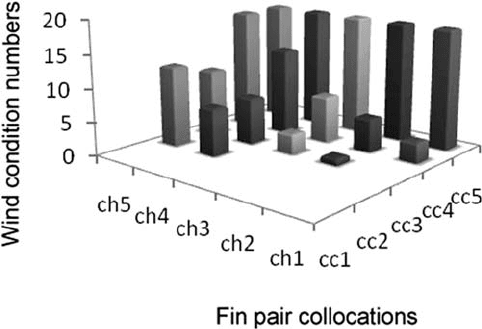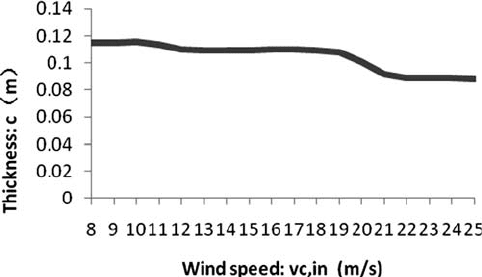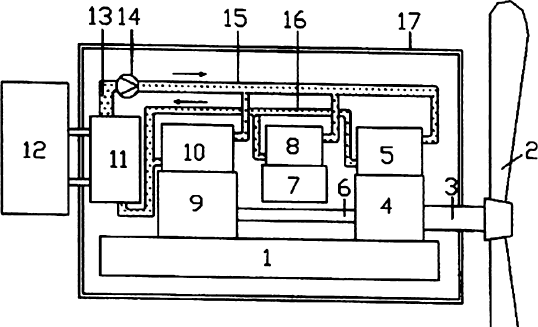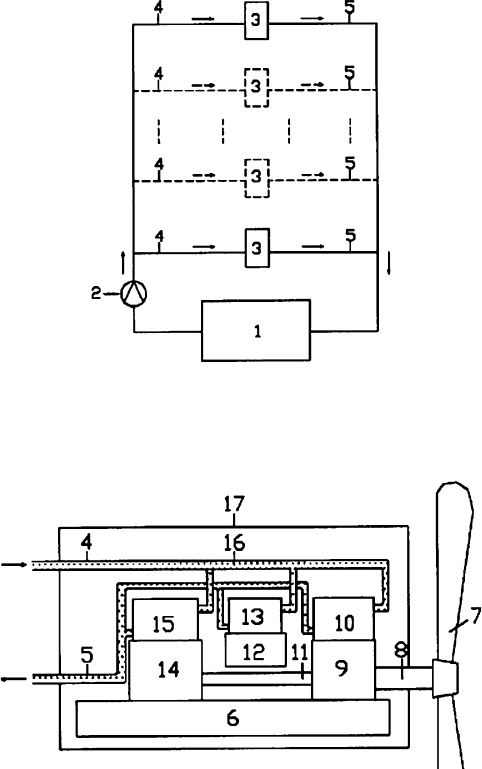Tong W. Wind Power Generation and Wind Turbine Design
Подождите немного. Документ загружается.

Wind Turbine Cooling Technologies 625
4.1.3.4 Anti-corrosion measures
The heat exchanger exposed to the external environment is prone to be corroded,
which will affect the durable, reliable operation of the heat exchanger. Therefore,
necessary anti-corrosion treatments need to be implemented, like coating the alu-
minum fl akes with anti-corrosive allyl resin coverings and employing hydrophilic
membranes on its outer surface. Having been treated with this method, the acid
rainproof of the aluminum fi ns and the anti-salt corrosion property can be 5–6 times
as large as those of the ordinary ones. In the design of the heat exchanger, due to
relatively large difference of the cooling system operating loads in winter and
summer, the summer operating mode is adopted as the design condition, while the
heat transfer effi ciency can be controlled through a bypassing method in winter.
4.1.4 Flow resistance calculation of the liquid cooling system
and pump selection
The liquid cooling pipeline system is comprised of a steel tube part and a pressure
hose part. In view of the various factors, the following pipe diameters should be
selected: steel tube and pressure hose diameter of the main trunk D
1
= 48 mm,
branch steel tube and pressure hose’s diameter D
2
= 42 mm. The on-way resistance
and local resistance can be calculated based on the selected tube diameter, with
which the circulating pump can be selected.
4.2 Optimization of the liquid cooling system
Based on the design method mentioned above, by utilizing MATLAB software, the
optimization of the liquid cooling system is performed. Since the external radiator
is the core component of the liquid cooling system, its structural dimension has an
important impact on the cooling effect of the wind turbine and the weight of the
nacelle. The subject of optimization in this section is the external radiator shown in
Fig. 5 . The constraint conditions are: the external radiator is fi xed in the frame on
top of the rear of the nacelle, with a limitation of frame size of 1.900 m × 0.820 m ×
0.200 m; and the actual maximum size of the core unit of the external radiator is
1.800 m × 0.800 m × 0.200 m excluding the size of stream sheet and head. Under
these conditions, the optimization procedure is shown as follows.
4.2.1 Derivation of the thickness of the heat exchanger core unit
The functional relation of the thickness of the heat exchanger can be derived from
the heat transfer equation and the heat transfer coeffi cient equation and so forth
as follows:
Total heat transfer:
hmh
QktF=Δ
(1 )
where Q is the heat transfer quantity of the heat exchanger, k
h
is the total heat
transfer coeffi cient on the liquid side, Δ t
m
is the heat transfer mean temperature
difference, F
h
is the total heat transfer area on the liquid side, given as
626 Wind Power Generation and Wind Turbine Design
h1
( ,cc,ch)Ffc=
( 2)
where c is the thickness of the core unit of the heat exchanger, cc is the dimension
of the fi n unit on the airside, and ch is the fi n unit dimension on the liquid side.
From eqns (1) and (2), the core unit thickness is obtained as
2hm
( , , ,cc,ch)cfQk t=Δ
( 3)
From the known condition:
3c,in
()Qfv=
( 4)
Total heat transfer coeffi cient:
h 4 c h 0,c 0,h c h
(,, ,,)kf FFhh=⋅aa
( 5)
Heat transfer coeffi cient on the airside:
c5c,in
(,cc)fv=a
( 6)
Heat transfer coeffi cient on the liquid side:
h6h
(,ch)fv=a
( 7)
Flow velocity of the fl uid:
h7
( ,cc,ch)vfc=
(8 )
Fin effi ciency on the air side:
0,c 8 c
(cc, )fha=
( 9)
Fin effi ciency on the liquid side:
0,h 9 h
(ch, )fha=
( 10)
Total heat transfer area on the airside:
c10
( ,cc,ch)Ffc=
( 11)
From eqns (2), (5) and (11), the total heat transfer coeffi cient based on the total
heat transfer area on liquid side can be expressed as
h11 c,in
( ,cc,ch, )kfc v=
( 12 )
Heat transfer mean temperature difference,
m 12 c,in c,out h,in h,out
(, , , )tfttttΔ=
( 13)
where t
c,in
and t
c,out
represent the inlet and outlet temperature of the air, t
h,in
and
t
h,out
are inlet and outlet temperatures of the ethylene glycol aqueous solution
respectively, in which t
c,in
and t
h,out
are known quantities.
Wind Turbine Cooling Technologies 627
In addition that
c,out 13 c,in
(cc,ch, , )tf vQ=
( 14 )
h,in 14
()tfQ=
(15 )
From eqns (13) and (15):
m15 c,in
( ,cc,ch, )tfc vΔ=
( 16 )
After substituting eqns (4), (12) and (16) into eqn (3), the functional relation of the
heat exchanger’s thickness can be simplifi ed to:
16 c,in
(cc,ch, )cf v=
( 17 )
On the basis of the deduced relational expression of the heat exchanger’s thickness,
the thickness dimension is optimized with a method as follows.
Assume that when the wind turbine is running the wind speeds v
c,in
are under n
different circumstances and, thus, there will be n pairs of generated output values
and heat dissipation values corresponding to them. After choosing a dimension
pair of the fi n (‘cc’ and ‘ch’ in the equation), n different thicknesses of the heat
exchanger core unit (‘ c ’) would be obtained, matching n circumstances, respec-
tively, according to the above equations. On this basis, by changing Z types of fi n
pairs on the air and liquid sides, Z heat exchanger core unit thicknesses meeting
design requirements ( c
max1
, c
max2
, …, c
max z
) can be obtained; therefore Z corre-
sponding resistance on the liquid side and the heat exchanger weight can be
obtained. The optimization computing task of the heat exchanger core unit is to
fi nd an air-and-liquid-side fi n pair solution that not only can meet the cooling
demands under various working condition, but also is able to minimize the system
power consumption or the total weight of the system.
4.2.2 Optimization procedure of the heat exchanger core unit
As the wind turbine usually works under the condition that the wind speed 1.
exceeds 8 m/s, thus only the condition with a wind speed ranging from 8 to
25 m/s will be considered. Giving a state point every time by increasing speed
of 1 m/s, the wind will be with 18 different velocities. The rated heat dissipating
capacity of the radiator corresponding to various wind velocities can be ob-
tained from the generator power graph, shown in Table 3 and Fig. 6 .
Based on the overall consideration of the maximum rated inlet temperature 2.
required for the generator and the control converter as well as the temperature
rise of fl uid in the pipeline network, the radiator outlet ethylene glycol aqueous
solution temperature can be selected as: t
h,out
= 43°C. Other hypotheses are the
same with the statement in Section 4.1.
Assuming that the airside fi n and the liquid side fi n are selected from one of the 3.
fi ve types of straight fi ns and one of the fi ve types of serrated fi ns, respectively,
the collocation types for the air and liquid side fi n pairs sums up to 25, with
their specifi c parameters shown in Table 4 .

628 Wind Power Generation and Wind Turbine Design
Table 3: Relationship between inlet air velocity
and heat dissipation of the heat exchanger [ 21 ].
v
c,in
(m/s) Q (kW)
8 41.5
949
10 56.5
11 62.5
12 64
13 64
14 64
15 64
16 64
17 64
18 64
19 64
20 64
21 64
22 64
23 64
24 64
25 64
The optimization procedure is shown in Fig. 8 . The computational procedure is
as follows. Firstly, choose an air and liquid side fi n pair. Secondly, read the wind
velocity and rated heat dissipating capacity of the heat exchanger and then calcu-
late the heat exchanger thickness c to satisfy these conditions using an iterative
method. Finally, calculate the weight of the heat exchanger core unit, pressure
drop on the liquid side and other parameters like heat exchanger effi ciency and so
forth until all the calculation completes.
4.2.3 Interpretation of the optimization computing result
4.2.3.1 Wind condition numbers corresponding to the calculated heat exchanger
thicknesses larger than 0.2 m based on various fi n pair collocations
After choosing any air and liquid side fi n pair, 18 heat exchanger thicknesses can
be obtained corresponding to 18 wind conditions in order to match the cooling
Table 4: Parameters of the air and liquid side fi n pairs [ 21 ].
Parameter
Types of the air side fi n pairs Types of the liquid side fi n pairs
cc1 cc2 cc3 cc4 cc5 ch1 ch2 ch3 ch4 ch5
Fin height,
L
c
(mm)
12 9.5 6.5 4.7 3.2 3.2 4.7 6.5 9.5 12
Fin height,
d c (mm)
0.15 0.2 0.3 0.3 0.3 0.3 0.3 0.3 0.2 0.15
Fin interval,
m c (mm)
1.4 1.7 1.7 2.0 4.2 4.2 2.0 1.4 1.7 1.4

Wind Turbine Cooling Technologies 629
demands of the system. The calculated results by MATLAB forms are in Fig. 9 .
It can be concluded from the fi gure that, as the fi n height on the airside declines,
the fi n height on the liquid side rises and the wind condition numbers with a heat
exchanger thickness exceeding 0.2 m increases correspondingly, thus leading to
an unreasonable collocation.
4.2.3.2 Selected heat exchanger thickness corresponding to different fi n pairs
and the weight of the heat exchanger
When the 18 values of c (heat exchanger thickness) are all less than 0.2 m corre-
sponding to 18 wind conditions, it indicates that this fi n pair can meet the system’s
cooling and dimension requirements simultaneously. Similarly, it can be found
that when the fi n pair is cc1 and ch1, indicating that the airside fi n height reaches
its maximum and that of the liquid side is of its minimum, the selected thickness
c
max
and weight W
max
is the smallest, and thus the structure of the heat exchanger
Figure 8: Flow chart of the optimization and computation of the radiator.
N
Y
Y
Y
Y
N
Read fin pairs on two sides
Read heat dissipating capacity Q and wind velocity v
c,in
Assume the radiator height c
Compute other fin parameters
Assume liquid side average t
h,av
?
compute parameters
Is this t
c,av
suitable?
Assume airside average t
c,av
?
compute parameters
Is t
c,out
<t
h,in
?
Compute the real radiator
height c
real
Does the default c =
c
real
?
Compute weight and efficiency of the
radiator and pressure drop on liquid side;
Output data
Change
t
c,av
Change
t
h,av
Change c
Output “This is
fin pair is not
suitable”
N
N
Is T
c,av
suitable?

630 Wind Power Generation and Wind Turbine Design
is the most compact and lightest under this circumstance. Moreover, it can be
found in the fi gure that if the airside fi n size is changed and the liquid fi n size is
kept unchanged, there will be an obvious infl uence on the selected heat exchanger
thickness and weight; while if the liquid side fi n is changed instead of the airside
one, the change will be comparatively smaller.
It can be found from the above computing results, the heat exchanger adopting fi n
pair cc1 and ch1 can reach its lightest and most compact structure, which is, thus, in
favor of operating at a high altitude for the generating set. Considering that the liquid
side pressure drop is far less than that of the cooling medium running through the
generator and the control converter, this optimization focuses on the weight of the
cooling system. From computing results, the fi n pair cc1 and ch1 are adopted as
the optimum fi n pair. The results show that it would obtain a more effective fi n
function and comparatively higher fi n effi ciency by selecting low and thick fi n on
the liquid side with a large heat transfer coeffi cient and by selecting the high and
thin fi n on the small-heat-transfer-coeffi cient airside.
The relationship, shown in Fig. 10 [ 21 ], between the computed values of the
parameters and the wind speeds under 18 wind conditions adopting fi n pair cc1
and ch1 are computed by the commercial software, MATLAB. It can be concluded
from the modeling result that as the wind speed rises up, the computed values of
the heat exchanger thickness and the corresponding heat exchanger weight decline
gradually, while the pressure drop on the liquid side and the heat exchanger’s effi -
ciency increase continuously. The maximum heat exchanger thickness is 116 mm,
appearing at 10 m/s wind speed, and the pressure drop on liquid side is 341.5 Pa
which meets the system pressure drop requirements.
The above optimization of liquid cooling systems is limited to the computed
result of heat transfers and structural dimension and weight, and based on the
hypothesis of steady working condition and thus no comprehensive conclusion
can be drew for the dynamic property, power consumption and operating cost of
Figure 9: Wind condition numbers corresponding to heat exchanger thickness
exceeding 0.2 m based on various fi n pair collocations [ 21 ].

Wind Turbine Cooling Technologies 631
the wind turbine cooling system. In order to perform an exhaustive and objective
optimization of the system, we will utilize tools such as computer-aided design,
dynamic numerical simulation and so forth combining with the heat production
data in the real-time wind turbine operation to launch a thorough and meticulous
research. By doing these, we are able to render theoretical support to the future
design of high-performance, reliable and economic wind turbines.
5 Future prospects on new type cooling system
With the wide application of wind energy at coastline area, the unit capacity of
wind turbines increases greatly [ 22 ], which leads to a large rise of the heat produc-
tion in gearboxes, generators and converters. The current liquid cooling system
will no longer be suffi cient to meet the cooling demands of wind turbines. Besides,
the current cooling system has not taken full advantage of the ambient environ-
ment, such as high wind velocity, large solar energy density, etc. Therefore, there
is a great potential to improve the operation economical effi ciency. To solve the
two problems above, some new cooling techniques for wind turbines are proposed
in this section as follows.
5.1 Vapor-cycle cooling methods
From the theories of thermodynamics, all the current wind turbine cooling methods
absorb heat by utilizing the specifi c heat capacity of the medium, while the vapor-cycle
cooling uses the gasifi cation latent heat of the boiling fl uid to deliver the heat. As the
gasifi cation latent heat of the fl uid is much larger than its specifi c heat capacity, the effect
of the vapor-cycle cooling will be more obvious [ 24 ]. Therefore, the implementation of
the vapor-cycle cooling technology is worthy of consideration. As shown in Fig. 11 ,
its feature is that the system sets a vapor-cycle refrigerating engine outside the nacelle.
During the operation, the cooling medium fl ows through the heat exchangers which
is installed outside the gearbox, the generator, and the control converter successively,
Figure 10: Relationship between wind speed and thickness of the heat exhanger
adopting fi n pair cc1 and ch1.

632 Wind Power Generation and Wind Turbine Design
and take away the heat produced by these components. The heated cooling medium
fl ows through an evaporator, getting cooled by exchanging heat with the refrigeration
coolant circulating in the vapor-cycle refrigerating engine, and then perform the next
round of cooling driven by circulating pump, which ensures that every component
operates under a proper working condition. One thing worth mentioning is that the
refrigerating engine can use bellows as connections among the cooling medium heat
exchangers so that it will be more adaptable to the rotating working condition of the
nacelle because of the change in wind direction during its running. The condenser
of the refrigerating engine can be installed outside of the pylon in order to enhance
convective heat transfer.
Comparing with the current forced air cooling and the liquid cooling method,
the vapor-cycle cooling system introduces an extra cost of vapor-cycle refrigerat-
ing engine and additional power consumption for the cooling of the medium, how-
ever, it can adjust cooling capacity fl exibly according to the cooling demands, and
also can provide the optimal working condition for the wind turbine which paves
the way for the next generation of high-power wind turbines.
5.2 Centralized cooling method
The current cooling solutions and the one discussed in Section 5.1 all aim at one
single generating set. However, one with a complicated system is a prevalent issue,
which leads to a huge diffi culty for installation and maintenance, and, therefore,
lowers down the operating reliability and the economical effi ciency. Especially, with
Figure 11: Structural diagram of the wind turbine adopting vapor-cycle cooling
method: 1, saddle piece; 2, impeller blade; 3, low-speed shaft; 4, gearbox;
5, gearbox heat exchanger; 6, high-speed shaft; 7, control converter;
8, control converter heat exchanger; 9, generator; 10, generator heat
exchanger; 11, cooling medium heat exchanger; 12, vapor-cycle refrig-
erating engine; 13, cooling medium; 14, circulating pump; 15, cooling
medium inlet pipe; 16, cooling medium return pipe; 17, nacelle cover.

Wind Turbine Cooling Technologies 633
the increasing unit capacity of wind turbines, the heat production in the operation
procedure will increase sharply and the disadvantage mentioned above of the tradi-
tional stand-alone cooling method will be more acute. Hence, the centralized cool-
ing method is taken into consideration. As shown in Figs 12 and 13, the feature of a
centralized cooling system for wind turbines is that it sets a cooling unit in the wind
power plant, providing centralized cooling capacity to every wind turbine in it.
Figure 12: Schematic diagram of wind turbine centralized cooling system: 1, refriger-
ating engine; 2, circulating pump; 3, wind turbine; 4, cooling medium
carrier pipe; 5, cooling medium return pipe.
Figure 13: Structural diagram of wind turbine centralized cooling system:
6, saddle piece; 7, impeller blade; 8, low-speed shaft; 9, gearbox;
10, gearbox heat exchanger; 11, high-speed shaft; 12, control converter;
13, control converter heat exchanger; 14, generator; 15, generator heat
exchanger; 16, cooling medium; 17, nacelle cover.
634 Wind Power Generation and Wind Turbine Design
Similar with the wind turbine adopting vapor-cycle cooling method, the cooling
medium runs sequentially through the heat exchangers outside the gearbox, the
generator and the control converter, taking away the heat produced by these com-
ponents. The heated cooling medium is then delivered to the refrigerating engine
in the wind power plant through the cooling medium return pipe to get centralized
refrigerated and once again delivered back to every wind turbine through the
carrier pipe to perform the next round of cooling.
In a practical application, different types of air coolers or refrigeration units can
be selected for the cooling unit according to the cooling demands of the generator.
Compared with air coolers, refrigeration units are able to obtain lower cooling tem-
perature. When the individual refrigeration unit cannot suffi ce to the cooling
demands, multiple refrigeration units can be adopted; when the cooling demands are
changed because of climate, season and other factors, they can be fl exibly regulated
by just changing the number of devices in operation. As to the wind power plant with
a large-scale geographical area and a large number of generators, an alternative
option is to set several centralized refrigeration units at different proper locations,
according to the practical situation, to better satisfy the cooling demands and ratio-
nalize the distribution of the cooling medium delivery lines, aiming at obtaining high
dependability and economy. With regard to wind turbines under low operating tem-
perature, in order to reduce the cooling capacity wastage in the delivery of cooling
medium, the system can adopt those pipe lines with good heat-insulating property
and conduct some treatments of thermal insulation, such as coating the pipe with
heat-insulating layers etc. The carrier and return pipes of the cooling medium can be
laid out along with electric cables within the pylon so as to avoid corrosion of blown
sand and rain to the pipeline. Besides, the joint of the cooling medium carrier and
return pipe lines and the wind turbines can also be connected with bellows.
Compared with the forced air cooling and the liquid cooling systems, although the
initial cost and the operating cost of the centralized cooled wind power generating sys-
tem is higher, it has its own advantages, such as huge cooling capacity and fl exible
adaptability. Besides, the refrigeration units can aptly adopt various cooling manners
according to the operating requirements of the wind power devices so as to suffi ce to the
high-power cooling demands, which pave the way for the new generation of high-power
wind turbine sets. Comparing to the vapor-cycle cooling method, this system simplifi es
the internal cooling devices of the wind turbine, and lowers the operating weight to make
it suitable for the operation of wind turbines at a high altitude, which, thereby, eases the
maintenance of the devices. In addition, when dealing with cooling demand fl uctuation
caused by changing of season, climate or other factors, no adjustments to individual
wind turbines are required, but simply the adjustment to refrigeration units is needed.
5.3 Jet cooling system with solar power assistance
The cooling technologies and solutions mentioned above are all driven by elec-
tricity but the solar power as a clean energy from the atmosphere is omitted. This
omission, to some extent, lowers the generating effi ciency. Actually, the cur-
rent heat-driven cooling technique is fairly mature. Because of these, the solar
power jet cooling method can be implemented in the wind turbine cooling system.
